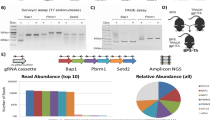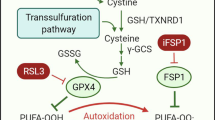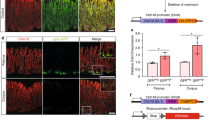Abstract
Non-neuronal expression of components of the glutamatergic system has been increasingly observed, and our laboratory previously had demonstrated the etiological role of ectopically expressed metabotropic glutamate receptor 1 (Grm1/mGluR1) in mouse models of melanoma. We hypothesize that inappropriate glutamatergic signaling in other cell types can dysregulate growth leading to transformation and tumorigenesis. As most cancers are carcinomas, we selected an immortalized primary baby mouse kidney (iBMK) cell model to assess whether Grm1 can transform epithelial cells. These iBMK cells, engineered to be immortal yet nontumorigenic and retaining normal epithelial characteristics, were used as recipients for exogenous Grm1 cDNA. Several stable Grm1-expressing clones were isolated and the Grm1-receptors were shown to be functional, as evidenced by the accumulation of second messengers in response to Grm1 agonist. Additionally activated by agonist were mitogen-activated protein kinase (MAPK) and AKT/protein kinase B signaling cascades, the major intracellular pathways shown by many investigators to be critical in melanomagenesis and other neoplasms. These Grm1-iBMK cells exhibited enhanced cell proliferation in in vitro methylthiazolyldiphenyl-tetrazolium bromide (MTT) assays and significant tumorigenicity in in vivo allografts. Persistent Grm1 expression was required for the maintenance of the in vivo tumorigenic phenotype as demonstrated by an inducible Grm1-silencing RNA. These are the first results that indicate that Grm1 can be an oncogene in epithelial cells. In addition, relevance to human disease in the corresponding tumor type of renal cell carcinoma (RCC) may be suggested by observed expression of GRM1/mGluR1 in a number of RCC tumor biopsy samples and cell lines, and the effects of GRM1 modulation on tumorigenicity therein. Moreover, RCC cell lines exhibited elevated levels of extracellular glutamate, and some lines responded to drugs, which modulate the glutamatergic system. These findings imply a possible role for glutamate signaling apparatus in RCC cell growth, and that the glutamatergic system may be a therapeutic target in RCC.
This is a preview of subscription content, access via your institution
Access options
Subscribe to this journal
Receive 50 print issues and online access
$259.00 per year
only $5.18 per issue
Buy this article
- Purchase on Springer Link
- Instant access to full article PDF
Prices may be subject to local taxes which are calculated during checkout










Similar content being viewed by others
References
Nicoletti F, Arcella A, Iacovelli L, Battaglia G, Giangaspero F, Melchiorri D . Metabotropic glutamate receptors: new targets for the control of tumor growth? Trends Pharmacol Sci 2007; 28: 206–213.
Frati C, Marchese C, Fisichella G, Copani A, Nasca MR, Storto M et al. Expression of functional mGlu5 metabotropic glutamate receptors in human melanocytes. J Cell Physiol 2000; 183: 364–372.
Genever PG, Maxfield SJ, Kennovin GD, Maltman J, Bowgen CJ, Raxworthy MJ et al. Evidence for a novel glutamate-mediated signaling pathway in keratinocytes. J Invest Dermatol 1999; 112: 337–342.
Tong Q, Ouedraogo R, Kirchgessner AL, Localization and function of group. III metabotropic glutamate receptors in rat pancreatic islets. Am J Physiol Endocrinol Metab 2002; 282: E1324–E1333.
Storto M, Capobianco L, Battaglia G, Molinaro G, Gradini R, Riozzi B et al. Insulin secretion is controlled by mGlu5 metabotropic glutamate receptors. Mol Pharmacol 2006; 69: 1234–1241.
Gill SS, Pulido OM, Mueller RW, McGuire PF . Immunochemical localization of the metabotropic glutamate receptors in the rat heart. Brain Res Bull 1999; 48: 143–146.
Storto M, de Grazia U, Knopfel T, Canonico PL, Copani A, Richelmi P et al. Selective blockade of mGlu5 metabotropic glutamate receptors protects rat hepatocytes against hypoxic damage. Hepatology 2000; 31: 649–655.
Melchiorri D, Cappuccio I, Ciceroni C, Spinsanti P, Mosillo P, Sarichelou I et al. Metabotropic glutamate receptors in stem/progenitor cells. Neuropharmacology 2007; 53: 473–480.
Morimoto R, Uehara S, Yatsushiro S, Juge N, Hua Z, Senoh S et al. Secretion of L-glutamate from osteoclasts through transcytosis. EMBO J 2006; 25: 4175–4186.
Young VR, Ajami AM . Glutamate: an amino acid of particular distinction. J Nutr 2000; 130: 892S–900S.
Pollock PM, Cohen-Solal K, Sood R, Namkoong J, Martino JJ, Koganti A et al. Melanoma mouse model implicates metabotropic glutamate signaling in melanocytic neoplasia. Nat Genet 2003; 34: 108–112.
Marin Y, Chen S . Involvement of metabotropic glutamate receptor 1, a G-protein-coupled receptor, in melanoma development. J Mol Med 2004; 82: 735–749.
Zhu H, Reuhl K, Zhang X, Botha R, Ryan K, Wei J et al. Development of heritable melanoma in transgenic mice. J Invest Dermatol 1998; 110: 247–252.
Shin SS, Martino JJ, Chen S . Metabotropic glutamate receptors (mGlus) and cellular transformation. Neuropharmacology 2008b; 55: 396–402.
Namkoong J, Shin SS, Lee HJ, Marin YE, Wall BA, Goydos JS et al. Metabotropic glutamate receptor 1 and glutamate signaling in human melanoma. Cancer Res 2007; 67: 2298–2305.
Yip D, Le MN, Chan JL, Lee JH, Mehnert JA, Yudd A et al. A phase 0 trial of riluzole in patients with resectable stage III and IV melanoma. Clin Cancer Res 2009; 15: 3896–3902.
Prickett TD, Wei X, Cardenas-Navia I, Teer JK, Lin JC, Walia V et al. Exon capture analysis of G protein-coupled receptors identifies activating mutations in GRM3 in melanoma. Nat Genet 2011; 43: 1119–1126.
Choi KY, Chang K, Pickel JM, Badger JD, Roche KW . Expression of the metabotropic glutamate receptor 5 (mGluR5) induces melanoma in transgenic mice. Proc Natl Acad Sci USA 2011; 108: 15219–15224.
Sharon D, Vorobiov D, Dascal N . Positive and negative coupling of the metabotropic glutamate receptors to a G protein-activated K+ channel, GIRK, in Xenopus oocytes. J Gen Physiol 1997; 109: 477–490.
Meldrum BS . Glutamate as a neurotransmitter in the brain: review of physiology and pathology. J Nutr 2000; 130: 1007S–1015S.
Hoogduijn MJ, Hitchcock IS, Smit NP, Gillbro JM, Schallreuter KU, Genever PG . Glutamate receptors on human melanocytes regulate the expression of MiTF. Pigment Cell Res 2006; 19: 58–67.
Milligan G . Receptors as kissing cousins. Science 2000; 288: 65–67.
Degenhardt K, White E . A mouse model system to genetically dissect the molecular mechanisms regulating tumorigenesis. Clin Cancer Res 2006; 12: 5298–5304.
Degenhardt K, Chen G, Lindsten T, White E . BAX and BAK mediate p53-independent suppression of tumorigenesis. Cancer Cell 2002; 2: 193–203.
Ferraguti F, Crepaldi L, Nicoletti F . Metabotropic glutamate 1 receptor: current concepts and perspectives. Pharmacol Rev 2008; 60: 536–581.
Marin YE, Namkoong J, Cohen-Solal K, Shin SS, Martino JJ, Oka M et al. Stimulation of oncogenic metabotropic glutamate receptor 1 in melanoma cells activates ERK1/2 via PKCepsilon. Cell Signaling 2006; 18: 1279–1286.
Shin SS, Wall B, Goydos JS, Chen S . AKT2 is a downstream target of metabotropic glutamate receptor 1 (mGlu1). Pigment Cell Melanoma Res 2010; 23: 103–111.
Degenhardt K, Sundararajan R, Lindsten T, Thompson C, White E . Bax and Bak independently promote cytochrome C release from mitochondria. J Biol Chem 2002a; 277: 14127–14134.
Anglard P, Trahan E, Liu S, Latif F, Merino MJ, Lerman MI et al. Molecular and cellular characterization of human renal cell carcinoma cell lines. Cancer Res 1992; 52: 348–356.
Carroll FY, Stolle A, Beart PM, Voerste A, Brabet I, Mauler F et al. BAY36-7620: a potent non-competitive mGlu1 receptor antagonist with inverse agonist activity. Mol Pharmacol 2001; 59: 965–973.
Prezeau L, Gomeza J, Ahern S, Mary S, Galvez T, Bockaert J et al. Changes in the carboxyl-terminal domain of metabotropic glutamate receptor 1 by alternative splicing generate receptors with differing agonist-independent activity. Mol Pharmacol 1996; 49: 422–429.
Jong YJ, Schwetye KE, O'Malley KL . Nuclear localization of functional metabotropic glutamate receptor mGlu1 in HEK293 cells and cortical neurons: role in nuclear calcium mobilization and development. J Neurochem 2007; 101: 458–469.
Garraway LA, Widlund HR, Rubin MA, Getz G, Berger AJ, Ramaswamy S et al. Integrative genomic analyses identify MITF as a lineage survival oncogene amplified in malignant melanoma. Nature 2005a; 436: 117–122.
Welch DR, Bisi JE, Miller BE, Conaway D, Seftor EA, Yohem KH et al. Characterization of a highly invasive and spontaneously metastatic human malignant melanoma cell line. Int J Cancer 1991; 47: 227–237.
Julius D, Livelli TJ, Jessell TM, Axel R . Extopic expresion of the serotonin 1c receptor and the triggering of malignant transformation. Science 1989; 244: 1057–1062.
Gutkind JS, Novotny EA, Brann MR, Robbins KC . Muscarinic acetylcholine receptor subtypes as agonist-dependent oncogenes. Proc Natl Acad Sci 1991; 88: 4703–4707.
Cicenas J . The potential role of Akt phosphorylation in human cancers. Int J Biol Markers 2008; 23: 1–9.
Hers I, Vincent EE, Tavare JM . Akt signalling in health and disease. Cell Signal 2011; 23: 1515–1527.
Hoshino R, Chatani Y, Yamori T, Tsuruo T, Oka H, Yoshida O et al. Constitutive activation of the 41-/43-kDa mitogen-activated protein kinase signaling pathway in human tumors. Oncogene 1999; 18: 813–822.
Kim EK, Choi EJ . Pathological roles of MAPK signaling pathways in human diseases. Biochim Biophys Acta 2010; 1802: 396–405.
Steelman LS, Chappell WH, Abrams SL, Kempf RC, Long J, Laidler P et al. Roles of the Raf/MEK/ERK and PI3K/PTEN/Akt/mTOR pathways in controlling growth and sensitivity to therapy-implications for cancer and aging. Aging 2011; 3: 192–222.
American Cancer Society. Cancer Facts & Figures. American Cancer Society, Atlanta, 2012.
Bracarda S . Metastatic renal cell carcinoma: pathogenesis and the current medical landscape. Eur Urol Suppl 2009; 8: 787–792.
Kohler BA, Ward E, McCarthy BJ, Schymura MJ, Ries LA, Eheman C et al. Annual report to the nation on the status of cancer, 1975-2007, featuring tumors of the brain and other nervous system. J Natl Cancer Inst 2011; 103: 714–736.
Mathew A, Devesa SS, Fraumeni JF, Chow WH . Global increases in kidney cancer incidence, 1973-1992. Eur J Cancer Prev 2002; 11: 171–178.
Schmid-Wendtner MH, Baumert J, Wendtner CM, Plewig G, Volkenandt M . Risk of second primary malignancies in patients with cutaneous melanoma. Br J Dermatol 2001; 145: 981–985.
Tihan T, Filippa DA . Coexistence of renal cell carcinoma and malignant lymphoma. A causal relationship or coincidental occurrence? Cancer 1996; 77: 2325–2331.
Teh J, Chen S . Metabotropic glutamate receptors and cancerous growth. WIREs Membr Transp Signal 2012; 1: 211–220.
Lappano R, Maggiolini M . G protein-coupled receptors: novel targets for drug discovery in cancer. Nat Rev Drug Discov 2011; 10: 47–60.
D’Onofrio M, Arcella A, Bruno V, Ngomba RT, Battaglia G, Lombari V et al. Pharmacological blockade of mGlu2/3 metabotropic glutamate receptors reduces cell proliferation in cultured human glioma cells. J Neurochem 2003; 84: 1288–1295.
Iacovelli L, Arcella A, Battaglia G, Pazzaglia S, Aronica E, Spinsanti P et al. Pharmacological activation of mGlu4 metabotropic glutamate receptors inhibits the growth of medulloblastomas. J Neurosci 2006; 26: 8388–8397.
Machado-Vieira R, Salvadore G, Ibrahim LA, Diaz-Granados N, Zarate CA . Targeting glutamatergic signaling for the development of novel therapeutics for mood disorders. Curr Pharm Des 2009; 15: 1595–1611.
Recasens M, Guiramand J, Aimar R, Abdulkarim A, Barbanel G . Metabotropic glutamate receptors as drug targets. Curr Drug Targets 2007; 8: 651–681.
Wieronska JM, Pilc A . Metabotropic glutamate receptors in the tripartite synapse as a target for new psychotropic drugs. Neurochem Int 2009; 55: 85–97.
Miller RG, Mitchell JD, Lyon M, Moore DH . Riluzole for amyotrophic lateral sclerosis (ALS)/motor neuron disease (MND). Cochrane Database Syst Rev 2007, CD001447.
Tripathi VB, Al-Chalabi A . Molecular insights and therapeutic targets in amyotrophic lateral sclerosis. CNS Neurol Disord Drug Targets 2008; 7: 11–19.
Le MN, Chan JL, Rosenberg SA, Nabatian AS, Merrigan KT, Cohen-Solal KA et al. The glutamate release inhibitor Riluzole decreases migration, invasion, and proliferation of melanoma cells. J Invest Dermatol 2010; 130: 2240–2249.
Lee HJ, Wall BA, Wangari-Talbot J, Shin SS, Rosenberg SA, Chan JL-K et al. Glutamatergic pathway targeting in melanoma; single agent and combinatorial therapies. Clin Cancer Res 2011; 17: 7080–7092.
Takano T, Lin JH, Arcuino G, Gao Q, Yang J, Nedergaard M . Glutamate release promotes growth of malignant gliomas. Nat Med 2001; 7: 1010–1015.
Seidlitz EP, Sharma MK, Saikali Z, Ghert M, Singh G . Cancer cell lines release glutamate into the extracellular environment. Clin Exp Metastasis 2009; 26: 781–787.
Sharma MK, Seidlitz EP, Singh G . Cancer cells release glutamate via the cystine/glutamate antiporter. Biochem Biophys Res Commun 2010; 391: 91–95.
Speyer CL, Smith JS, Banda M, Devries JA, Mekani T, Gorski DH . Metabotropic glutamate receptor-1: a potential therapeutic target for the treatment of breast cancer. Breast Cancer Res Treat 2012; 132: 565–573.
Levine AJ, Puzio-Kuter AM . The control of the metabolic switch in cancers by oncogenes and tumor suppressor genes. Science 2010; 330: 1340–1344.
Zhu H, Ryan K, Chen S . Cloning of novel splice variants of mouse mGluR1. Brain Res Mol Brain Res 1999; 73: 93–103.
Matsukura S, Jones PA, Takai D . Establishment of conditional vectors for hairpin siRNA knockdowns. Nucleic Acids Res 2003; 31: e77.
Wangari-Talbot J, Wall BA, Goydos JS, Chen S . Functional Effects of GRM1 Suppression in Human Melanoma Cells. Mol Cancer Res (e-pub ahead of print 13 July 2012; doi:10.1158/1541-7786.MCR-12-0158).
Thandi S, Blank JL, Challiss RA . Group-I metabotropic glutamate receptors, mGlu1a and mGlu5a, couple to extracellular signal-regulated kinase (ERK) activation via distinct, but overlapping, signalling pathways. J Neurochem 2002; 83: 1139–1153.
Cohen-Solal KA, Crespo-Carbone SM, Namkoong J, Mackason KR, Roberts KG, Reuhl KR et al. Progressive appearance of pigmentation in amelanotic melanoma lesions. Pigment Cell Res 2002; 15: 282–289.
Wu TY, Saw CL, Khor TO, Pung D, Boyanapalli SS, Kong AN . In vivo pharmacodynamics of indole-3-carbinol in the inhibition of prostate cancer in transgenic adenocarcinoma of mouse prostate (TRAMP) mice: Involvement of Nrf2 and cell cycle/apoptosis signaling pathways. Mol Carcinog 2012; 51: 761–770.
Stepulak A, Sifringer M, Rzeski W, Endesfelder S, Gratopp A, Pohl EE et al. NMDA antagonist inhibits the extracellular signal-regulated kinase pathway and suppresses cancer growth. Proc Natl Acad Sci USA 2005; 102: 15605–15610.
Acknowledgements
This work was supported by grants R01CA108720 and 09-1143-CCR-EO (SC) and PhD fellowship from the Department of Physiology and Pharmacology, University of Rome "Sapienza", Rome, Itally (EM). We would like to acknowledge the generosity of Dr WM Linehan (Center for Cancer Research, National Cancer Institute, Bethesda, MD, USA) for RCC lines, Dr Daiya Takai (The University of Tokyo Hospital, Tokyo, Japan) for TetR plasmid components, Dr Tony Kong (Ernest Mario School of Pharmacy, Rutgers University, Piscataway, NJ, USA) for Aperio digital slide scanning/quantification system access and Dr Hao Wu (The Cancer Institute of New Jersey, New Brunswick, NJ, USA) for keen pathological insights.
Author information
Authors and Affiliations
Corresponding author
Ethics declarations
Competing interests
The authors declare no conflict of interest.
Additional information
Supplementary Information accompanies the paper on the Oncogene website
Supplementary information
Rights and permissions
About this article
Cite this article
Martino, J., Wall, B., Mastrantoni, E. et al. Metabotropic glutamate receptor 1 (Grm1) is an oncogene in epithelial cells. Oncogene 32, 4366–4376 (2013). https://doi.org/10.1038/onc.2012.471
Received:
Revised:
Accepted:
Published:
Issue Date:
DOI: https://doi.org/10.1038/onc.2012.471
Keywords
This article is cited by
-
Blocked metabotropic glutamate receptor 5 enhances chemosensitivity in hepatocellular carcinoma and attenuates chemotoxicity in the normal liver by regulating DNA damage
Cancer Gene Therapy (2022)
-
Participation of xCT in melanoma cell proliferation in vitro and tumorigenesis in vivo
Oncogenesis (2018)
-
The miR-487b-3p/GRM3/TGFβ signaling axis is an important regulator of colon cancer tumorigenesis
Oncogene (2017)
-
Inhibitors of glutamate release from breast cancer cells; new targets for cancer-induced bone-pain
Scientific Reports (2015)
-
Metabotropic glutamate receptor 1 acts as a dependence receptor creating a requirement for glutamate to sustain the viability and growth of human melanomas
Oncogene (2015)



